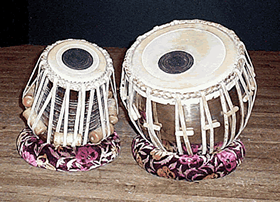Tablas: Hand drums from India
Used in Northern Indian Classical Music. Set of two drums played by hand. The larger drum usually made of copper or clay is called a Bayan, and the smaller drum is called a Tabla. The set is referred to as a Tabla Set. Two of my favorite players are Zakir Hussein and Trilok Gurtu.
The heads on these drums are usually made of goat skin. The heads have three distinct parts and is able to produce a variety of separate tones depending on how and where it is struck. The main head which is stretched across the drum is the Sur or maidan, a ring of skin (on top of the Sur) around the outer edge of the head is called the Kinar or kani, and the round black circle is called the Gab. The Gab is made of iron filings and rice paste which is constructed of circular layers decreasing in size. In addition, the pitch of the Bayan is typically modulated by pressure from the wrist.

Hear the Tablas on 'Bop-Ras', 'Dizi Gigue' and 'Bar-Bar-A' from 'Svadharma' and on 'Sa Ta Na Ma' from 'Sa Ta Na Ma'
One of the most interesting aspects of tabla music is the use of bols (syllables) which represent specific strokes. This enables players of tabla music to recite entire compositions or short excercises to each other. Consequently, the music has been passed down as an oral tradition and only in this century have written compositions using thes bols become generally available. On the smaller drum (tabla) the stroke "ta" is most often used for a stroke on the outer edge which produces a ringing or open tone. The stroke "Ge" on the larger drum (bayan) is also an open tone. "Dha" is the bol used when "Ta" and "Ge" are played at the same time.
The tabla is tuned by adjusting the tension on the head using leather straps and wooden pegs. They can easily fall out of tune during a performance and it is common to see a performer tune the drum (using a hammer on the tabla or the heel of his hand on the bayan) during a piece.
Read about the history of the tabla.